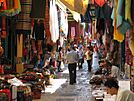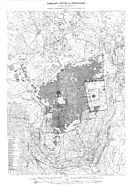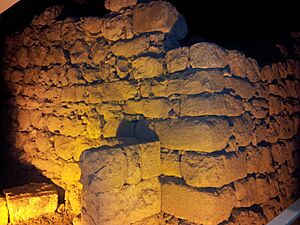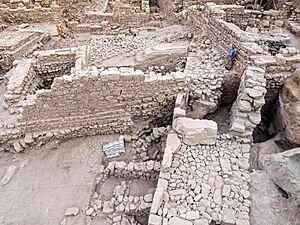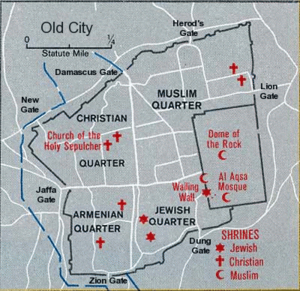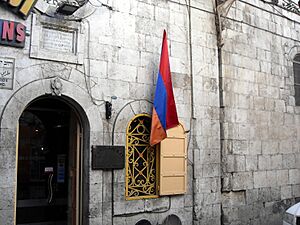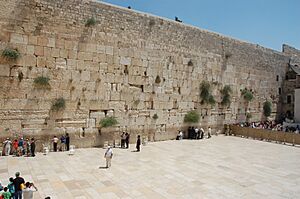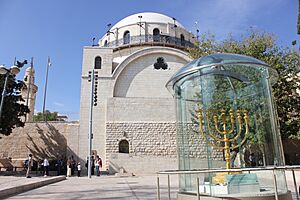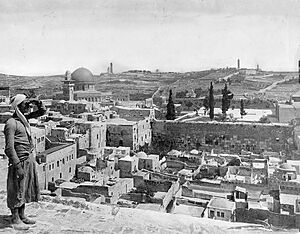Old City of Jerusalem facts for kids
| UNESCO World Heritage Site | |
|---|---|
|
Clockwise from top:
|
|
| Location | East Jerusalem |
| Criteria | Cultural: ii, iii, vi |
| Inscription | 1981 (5th Session) |
| Endangered | 1982–present |
The Old City of Jerusalem (Arabic: المدينة القديمة, romanized: al-Madīna al-Qadīma, Hebrew: הָעִיר הָעַתִּיקָה, romanized: Ha'ír Ha'atiká) is a special area in East Jerusalem. It is a walled city that covers about 0.9 square kilometers (0.35 square miles).
The Old City is divided into four main parts, called quarters. These are the Muslim Quarter, the Christian Quarter, the Armenian Quarter, and the Jewish Quarter. There is also a fifth important area called the Temple Mount. Muslims know it as Al-Aqsa or Haram al-Sharif. This area is home to the famous Dome of the Rock and the Al-Aqsa Mosque. Long ago, it was also the site of the Jewish Temple.
The walls and gates you see today around the Old City were built a long time ago. The Ottoman Empire built them between 1535 and 1542. This happened when Suleiman the Magnificent was in charge. The Old City holds many very important and holy places for three major religions. These are Judaism, Christianity, and Islam. For Jews, there is the Temple Mount and the Western Wall. For Christians, there is the Church of the Holy Sepulchre. For Muslims, there are the Dome of the Rock and the Al-Aqsa Mosque. Because of its great importance, the Old City and its walls were added to the World Heritage Site list by UNESCO in 1981.
Even though it's called the Old City, its current shape is different from how it looked in ancient times. Many experts believe that the City of David was the first settlement. This ancient site is south of the Temple Mount. Over time, the city grew to the east and north. It covered places like Mount Zion and the Temple Mount. The Old City we see today, with Suleiman's walls, is a bit further north. It is also smaller than it was during its biggest period, which was the late Second Temple period.
Until the mid-19th century, Jerusalem was mostly inside these Old City walls. Later, the city started to grow outside the walls. New neighborhoods and villages became part of Jerusalem. After the 1948 Arab–Israeli War, the Old City came under Jordanian control. Then, during the Six-Day War in 1967, Israel took control of East Jerusalem. Since then, the entire city has been under Israeli control. In 1980, Israel stated that all of Jerusalem was its capital. However, under international law, East Jerusalem is seen as territory occupied by Israel.
Contents
Who Lives in the Old City?
In 1967, about 17,000 Muslims lived in the Old City. There were also 6,000 Christians, including Armenians. At that time, no Jews lived there.
Today, most people in the Old City live in the Muslim Quarter. In 2007, the total population was about 37,000 people. This included 27,500 Muslims, 5,681 non-Armenian Christians, 790 Armenians, and 3,089 Jews. By 2020, the Old City's population had dropped to about 31,120 people.
A Look at the Old City's Past
Early History: Israelite Period

The Hebrew Bible tells us that before King David took over Jerusalem, the Jebusites lived there. The Bible says the city had very strong walls, and archaeological finds agree with this. King David's city was called the City of David. It was located southeast of the current Old City walls.
Later, King David's son, King Solomon, made the city walls bigger. He included the Temple and Temple Mount within them. After the United Kingdom of Israel split, Jerusalem became the capital of the Kingdom of Judah.
Jerusalem grew much larger to the west after the Neo-Assyrian empire destroyed the northern Kingdom of Israel. Many refugees came to Jerusalem. King Hezekiah got ready for an Assyrian attack. He made the capital's walls stronger and built towers. He also built a tunnel, the Siloam Tunnel, to bring fresh water into the city. Another important defense he built was the Broad Wall.
The First Temple period ended around 586 BCE. This is when Nebuchadnezzar's Neo-Babylonian Empire conquered Judah and Jerusalem. They destroyed Solomon's Temple and the city.
Rebuilding and Roman Times: Second Temple Period
In 538 BCE, the Persian King Cyrus the Great invited the Jews who were living in Babylon to return to Judah. He wanted them to rebuild the Temple. The Second Temple was finished in 516 BCE. This was 70 years after the first Temple was destroyed.
Around 440 BCE, the city was rebuilt again, but it was smaller. This happened during the Persian period. The Bible says Nehemiah led the Jews who returned from Babylon. Later, King Herod the Great built a "Second Wall." He also made the Temple Mount much bigger and rebuilt the Temple. From 41 to 44 CE, Agrippa I, the king of Judea, started building a "Third Wall" around the northern parts of the city. However, the entire city was completely destroyed by the Romans in 70 CE.
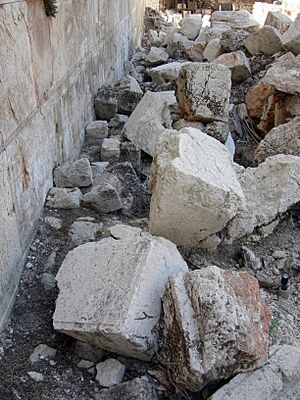
Later Empires: Roman, Byzantine, and Early Muslim Periods
The northern part of Jerusalem was rebuilt by Emperor Hadrian around 130 CE. He named it Aelia Capitolina. During the Byzantine period, Jerusalem grew southwards. City walls were built around it again.
Muslims took control of Byzantine Jerusalem in 637 CE. This happened under the second caliph, `Umar Ibn al-Khattab. He added Jerusalem to the Islamic Arab Empire. He promised to protect the people living there. Sophronius, a Christian leader, welcomed `Umar. He believed `Umar was a protector for the Christians of Jerusalem. `Umar visited the Church of the Holy Sepulchre. He prayed outside the church to make sure Muslims in the future would not try to turn it into a mosque.

Crusaders and Ayyubids
In 1099, Christian armies from the First Crusade captured Jerusalem. They held it until 1187, when Arab Muslims led by Saladin took it back. Saladin invited Jews to return and live in the city. In 1219, the city walls were torn down by Sultan Al-Mu'azzam of Damascus.
Later, in 1229, Jerusalem came under the control of Frederick II of Germany through a treaty with Egypt. He started rebuilding the walls in 1239, but they were destroyed again. In 1243, Christians controlled Jerusalem again, and the walls were repaired. However, the Khwarazmian Turks took the city in 1244. Sultan Malik al-Muazzam destroyed the walls again, leaving the city without defenses.
Ottoman Rule and Modern Walls
The walls of the Old City that you see today were built by the Ottoman Turkish sultan Suleiman the Magnificent. This happened between 1535 and 1542. These walls are about 4.5 kilometers (2.8 miles) long. They are between 5 and 15 meters (16 to 49 feet) high. At their base, they are about 3 meters (10 feet) thick.
The Old City walls have 35 towers. Fifteen of these towers are on the northern wall, which was more open to attacks. Suleiman's walls had six gates. A seventh gate, the New Gate, was added in 1887. Some older gates were closed up over the centuries. The Golden Gate was rebuilt and left open at first, but then it was walled up again. The New Gate was opened in the Christian Quarter during the 19th century. Two smaller, older gates were reopened recently on the southeastern side after archaeological work.
UNESCO Status
In 1980, Jordan suggested that the Old City should be listed as a UNESCO World Heritage Site. It was added to the list in 1981. In 1982, Jordan asked for it to be put on the List of World Heritage in Danger. The United States government did not agree with this request. They said Jordan did not have the right to make such a request. They also said Israel's agreement would be needed, as Israel controlled Jerusalem. In 2011, UNESCO stated again that East Jerusalem is "part of the occupied Palestinian territory." They also said that Jerusalem's future status must be decided through talks.
Discovering the Past: Archaeology
Ancient Israelite Finds
Archaeologists have found parts of the Old City walls from the 8th and 7th centuries BCE. These finds are in the area of the Israelite Tower. They likely include parts of a gate where many projectiles were found. This shows the Babylonian attack on Jerusalem in 586 BCE. Another part of a late 8th-century BCE wall was found. It was called the "broad wall" because of how it was described in the Book of Nehemiah. This wall was built to protect Jerusalem from the Assyrian siege of Jerusalem in 701 BCE.
Greek Period Discoveries
In 2015, archaeologists found parts of a large fort built by Greeks. It was in the center of old Jerusalem. Many believe it is the Acra fortress. The team also found coins from the time of Antiochus IV to Antiochus VII. They also found Greek arrowheads, slingshots, and large stones used for throwing.
In 2018, a small gold earring was found. It was only 4 centimeters long and had a ram's head design. It was found about 200 meters south of the Temple Mount. The Israel Antiquities Authority said it was from the early Hellenistic period (3rd or early 2nd century BCE). They said it was the first time a gold earring from that time was found in Jerusalem.
Herod's Time Discoveries
Many buildings from the time of King Herod were found in the Jewish Quarter. This happened during digs between 1967 and 1983. One find was a large mansion. It is thought to be the home of Annas the High Priest. Near it, a picture of the Temple menorah was found carved into a wall. This carving was made while the real menorah was still in the Temple. This palace was destroyed during the Roman attack in 70 CE. Another building, called the Burnt House, was also found nearby.
In 1968, the Trumpeting Place inscription was found at the southwest corner of the Temple Mount. It is believed to mark where priests announced the start of Shabbat and other Jewish holidays.
Byzantine Period Discoveries
In the 1970s, during excavations of the Nea Church, a Greek inscription was found. It said that Emperor Flavius Justinian helped build the church. Another inscription with Justinian's name was found in 2017. It was found in the ruins of a pilgrim hostel. This shows how important the Nea complex was at that time.
The Old City's Quarters
The Old City is divided into four main parts: the Muslim Quarter, the Christian Quarter, the Armenian Quarter, and the Jewish Quarter. This way of dividing the city might have started with a British map in 1841. There used to be a fifth area, the Mughrabi Quarter, but it was removed after the Six-Day War.
These quarters show how the city grew over time. Before, it was divided into many smaller neighborhoods. Even though they have names like "Muslim" or "Jewish," people from different groups used to live in all of them. For example, some houses in the Muslim quarter were rented to Jews.
Below is a table showing how the city's quarters were recorded over time:
| Local divisions | Western divisions | |||||
|---|---|---|---|---|---|---|
| Date | 1495 | 1500s | 1800s | 1900 | 1840s onwards | |
| Source | Mujir al-Din | Ottoman census | Traditional system | Ottoman census | Modern maps | |
| Quarters | Ghuriyya (Turiyya) | Bab el-Asbat | Muslim Quarter (north) | North-east | ||
| Bab Hutta | Bab Hutta | Bab Hutta | Bab Hutta | |||
| Masharqa | ||||||
| Bani Zayd | Bani Zayd | Sa'diyya | Sa'diyya | North-west | ||
| Bab el-'Amud | Bab el-'Amud | Bab el-'Amud | Bab el-'Amud | |||
| Bani Murra | ||||||
| Zara'na | Dara'na | Haddadin | Nasara | Christian Quarter | North | |
| Khan ez-Zeyt | East | |||||
| Nasara ("Christian") | Nasara | Middle and south | ||||
| Mawarna | ||||||
| Jawalda | Jawalda | West | ||||
| Bani Harith | Bani Harith | Jawa'na | Sharaf | Armenian Quarter | West | |
| Dawiyya | North | |||||
| Arman ("Armenian") | Sihyun | Arman | South | |||
| Yahud ("Jewish") | Yahud | East | ||||
| Risha | Silsila | Jewish Quarter | South | |||
| Maslakh | ||||||
| Saltin | Khawaldi | |||||
| Sharaf | Sharaf (Alam) | |||||
| 'Alam | North | |||||
| Magharba ("Moroccan / Maghrebi") | Magharba | Magharba | East | |||
| Marzaban | Bab el-Qattanin | Bab es-Silsila | Wad | Muslim Quarter (south) | South | |
| Qattanin | ||||||
| Aqabet es-Sitta | Wad | |||||
| 'Aqabet et-Takiya | ||||||
| (Outside the city walls) | Nebi Daud | Mount Zion | ||||
Muslim Quarter
The Muslim Quarter (Arabic: حارَة المُسلِمين, Hārat al-Muslimīn) is the largest quarter. It has the most people living in it. It is in the northeastern part of the Old City. It stretches from the Lions' Gate in the east to the Damascus Gate in the west. It also runs along the northern wall of the Temple Mount.
In the past, this quarter had people from different backgrounds. Muslims, Christians, and Jews all lived there until the riots of 1929. Today, many Israeli homes and religious schools (called yeshivas) are in the Muslim Quarter. In 2020, about 21,850 people lived there.
Christian Quarter
The Christian Quarter (Arabic: حارة النصارى, Ḩārat an-Naşāra) is in the northwestern part of the Old City. It goes from the New Gate in the north down to the Jaffa Gate. It borders the Jewish and Armenian Quarters. It also borders the Muslim Quarter near the Damascus Gate.
This quarter is home to the Church of the Holy Sepulchre. Many people consider this to be the holiest place for Christians. In 2020, about 3,870 people lived in the Christian Quarter.
Armenian Quarter
The Armenian Quarter (Armenian: Հայկական Թաղամաս, Haygagan T'aġamas, Arabic: حارة الأرمن, Ḩārat al-Arman) is the smallest of the four quarters. Even though Armenians are Christian, their quarter is separate from the main Christian Quarter. The Armenians and their church leaders (Patriarchate) are very independent. They have a strong presence in the Old City.
After the 1948 Arab–Israeli War, the four quarters came under Jordanian control. In 2007, about 2,424 people lived in this quarter. By 2020, the population was about 2,160.
Jewish Quarter
The Jewish Quarter (Hebrew: הרובע היהודי, HaRova HaYehudi) is in the southeastern part of the walled city. It stretches from the Zion Gate in the south to the Western Wall and the Temple Mount in the east. It borders the Armenian Quarter to the west.
This quarter has a very long history. Jewish people have lived here for much of the time since the 8th century BCE. In 1948, about 2,000 Jewish residents were forced to leave. The quarter was heavily damaged during the Battle for Jerusalem.
The Jewish Quarter remained under Jordanian control until 1967. Then, Israeli paratroopers took control during the Six-Day War. A few days later, Israeli authorities decided to remove the nearby Moroccan Quarter. This was done to make it easier for people to reach the Western Wall. Many buildings were destroyed, and people had to move.
After the Six-Day War in 1968, Israel took control of 12% of the Old City for public use. This included the Jewish Quarter and nearby areas. Most of these properties were not owned by Jews. After rebuilding the parts that were destroyed before 1967, these properties were offered for sale only to Israelis and Jews. Many previous owners did not want money for their properties. This was often because their properties were part of Islamic or family trusts (called waqfs), which cannot be sold. As of 2005, about 2,348 people lived in the Jewish Quarter. Many large schools and religious institutions are now there.
Before it was rebuilt, the quarter was carefully dug up by archaeologists. The things they found are now shown in museums and outdoor parks. Visitors can go down two or three stories below the current city level to see them. In 2020, the population of the Jewish Quarter was about 3,240.
Mughrabi Quarter
There used to be a small Mughrabi Quarter in the Old City. About a week after the Six-Day War ended, most of this quarter was removed. This was done to create the Western Wall Plaza and give visitors better access to the Western Wall. The parts of the quarter that were not removed are now part of the Jewish Quarter. At the same time, a new rule was made. Now, the only way for non-Muslims to enter the Temple Mount is through the Gate of the Moors. This gate is reached by the Mughrabi Bridge.
Gates of the Old City
The city walls have changed over time, and so has the number of gates. For example, during the time of the Crusaders, Jerusalem had four gates, one on each side. The current walls were built by Suleiman the Magnificent. He built six gates. Some older gates that were already closed before the Ottomans arrived were left that way. The Golden Gate was first rebuilt and left open by Suleiman, but then it was closed up again soon after.
The number of working gates became seven after the New Gate was added in 1887. A smaller gate, called the Tanners' Gate, was opened for visitors after being found during archaeological digs in the 1990s. There are also other old gates that are now closed. These include the double Golden Gate in the eastern wall, and the Single, Triple, and Double Gates in the southern wall. Archaeologists have found traces of other gates too, like the Gate of the Essenes on Mount Zion.
Until 1887, every gate was closed before sunset and opened at sunrise. These gates have been known by many different names throughout history and by different groups of people.
Images for kids
See also
 In Spanish: Ciudad vieja de Jerusalén para niños
In Spanish: Ciudad vieja de Jerusalén para niños



